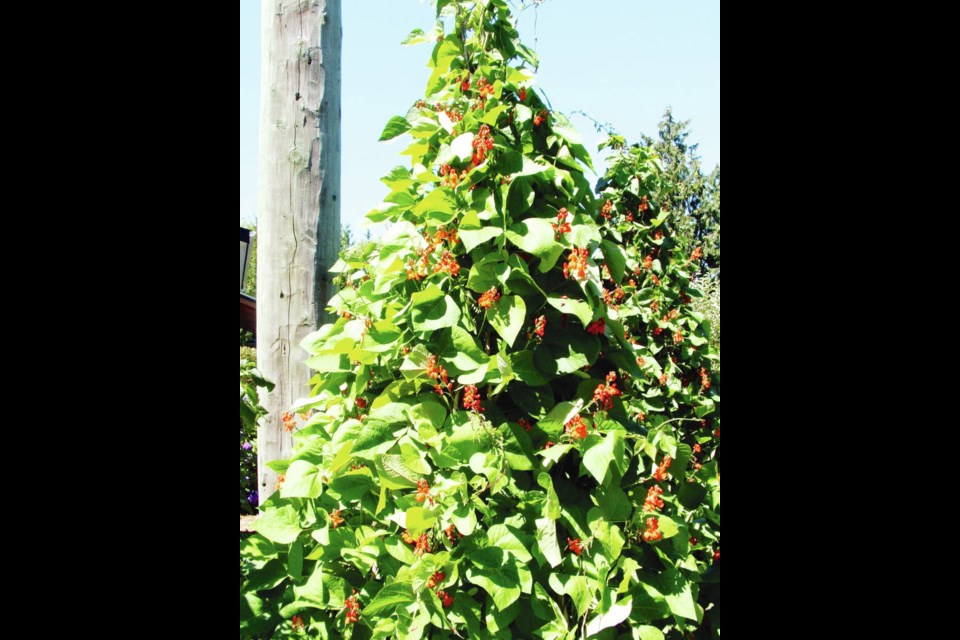Dear Helen: The green and purple bush beans I grew in containers produced well, but the scarlet runner beans dropped most of their flowers. How can I prevent this next year? The plants were adequately watered, and there were plenty of bees around.
R.B.
Blossom drop is a common issue with runner bean vines, which do not form pods easily in heat. A lack of adequate soil moisture sometimes contributes to the problem.
Runner beans are botanically different from bush and pole beans, which thrive in heat. The stress of high temperatures makes pod formation difficult for these bean plants, which are also more vigorous than pole bean vines. Runners are bound to have difficulty producing well in containers.
For satisfactory yields of runner beans, plant earlier than bush and pole beans, so that the vines can get a good start in cool conditions. Prepare the soil well with additions of compost, fertilizer and lime. With warm weather, mulch the vines well with more compost and then heat-deflecting straw to keep the soil cool and to help retain moisture.
Dear Helen: Why do my kiwis remain the size of a 25-cent coin? Last year I had my first harvest, of small, sweet, juicy kiwis. This year they look to be about the same size. They are the smooth-skinned type.
P.S.
The fuzzy-skinned kiwi (Actinidia deliciosa) produces fruit the size of large eggs. You are growing the hardy kiwi (Actinidia arguta), which yields smooth-skinned fruit the size of a grape. Hardy kiwis are also called “kiwi berries” — an indication of their size. Both kinds of kiwi grow on very vigorous vines. For optimum size and sweetness in the fruit of both, prune away overgrowth that is shading the fruit as it develops from around midsummer onward. And keep the plants watered regularly during dry weather.
Dear Helen: How can I deal with bamboo coming into my garden from a neighbour’s yard?
D.K.
“Running” kinds of bamboo spread on rhizomes, underground stems that produce roots and above-ground growth. The first thing to do is separate the rhizomes on your property from those of the parent plant on the neighbour’s side. As long as they remain connected, the parent portion will continue to support growth in the plants on your side.
Dig down along the property line to find the rhizomes. Use a sharp shovel or a saw to sever them. The next step is to keep cutting down any top growth that appears, to gradually starve the rhizomes.
Every spring, check the property line again and dig down to check the advance of any new rhizomes creeping into your garden.
Dear Helen: Every spring my wife and I struggle over deciding how much and what kind of potting soil to buy. My wife plants several large pots with flowers and vegetables. We wonder whether we need new soil every year and we’re never sure what brand(s) to buy.
R.H.
If you garden mainly, or solely, in large pots, you can make them work for you year round — if you wish. At summer’s end, remove spent flower and vegetable plants and replant with hardy fall and winter greens and with flowers like pansies and violas. In the spring, replant with summer vegetables and flowers.
Before each replanting, remove and replace at least one-third of the potting mix with fresh. I usually replace around a half.
Now, to your question of what to buy and how much. The quantity will depend on the number of containers you need to fill, or partially refill, at each planting. Leftover bags of planting mix store well over the winter if they are kept in a dry place.
Choosing products for planting mixes became tricky this year. The two main products I use for seeding and potting were nowhere to be found in my area. The pandemic disrupted supply lines and caused many products to be quickly sold out as interest in gardening exploded.
If you have been happy with your container plantings in recent years, continue with the potting mix you have used — or with a comparable one. Most outlets offer several choices. Look for “all purpose” on the label, then read the ingredients. I found a new (to me) product this year with peat, compost, kelp and coir (coconut fibre) in it. The label had directions for both potting and seeding, confirming its all-purpose nature.



